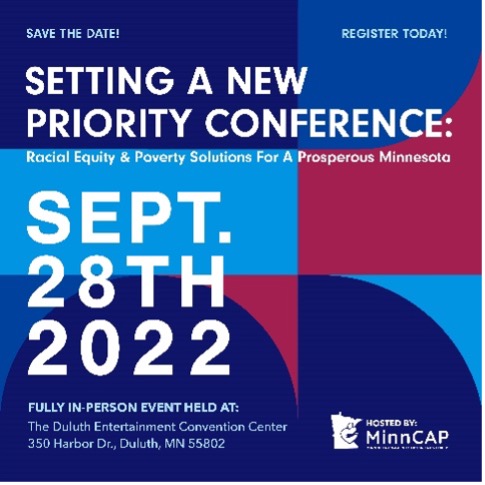
We are proud to partner with the Minnesota Community Action Partnership in the “Setting a New Priority: Racial Equity and Poverty Solutions for a Prosperous Minnesota” conference on September 28, 2022, in Duluth.
Attendees will explore the relationship between race and poverty, hear from nationally-recognized experts, nonprofit leaders, government officials, and those with lived experiences. By the end of the day, conference participants will help shape a statewide call to action.
September 28, 2022
Duluth Entertainment and Conference Center
9:30 a.m. to 4:30 p.m. followed by a social reception
The day will provide a full range of opportunities to get engaged. Leaders from Trellis will take an active part in these two sessions. We hope to see you there.
The impact of multiple benefits cliff: the end of additional COVID-19 funding and the cliff effect
Sept 28, 1:30 – 2:15 p.m.
Dawn Simonson, Trellis; Lorna Schmidt, Catholic Charities; Tina Rucci, Greater Twin Cities United Way; Facilitator: Annie Shapiro, Advocacy Director, MinnCAP
Policymakers and social service providers have long known about the cliff effect, or the impact even a small raise can have on a household’s ability to maintain their benefits. With the additional funding for social service and welfare programs during COVID-19 coming to an end, we are about to experience an additional benefits cliff of a severe decline in funding for programs. This session will discuss both of these concurrent cliff effects, how they will impact people with low incomes and low wealth, and policy solutions to mitigate them.
The Silent Epidemic: The Lethal Combination of Aging, Poverty and Race
Sept 28, 2:30 – 3:15 p.m.
LeAnn Littlewolf, Co-Executive Director, American Indian Community Housing Organization; Vanne Owens Hayes, Board Member, Trellis; Sherrie Pugh, Chair, Governor’s Council on an Age Friendly Minnesota; Facilitator: John Doan, Vice President for Operations and Equity, Trellis
“There’s a myth that Social Security and Medicare miraculously take care of all of people’s needs in older age. The reality is they don’t, and far too many people are one crisis away from economic insecurity.” Ramsey Alwin, President and CEO of the National Council on Aging. Layer on a lifetime of racial disparities in education, wealth and health and you have a silent epidemic. Case in point, the life expectancy in the US in 2019 for white, non-Hispanic was 78.8 years and 74.7 years for a Black, non-Hispanic Americans, a striking 4.1-year shorter lifespan based on race. COVID-19 further exacerbated this disparity as Black Americans make up 13% of the population and were 23% of COVID-19 deaths. What can we do about this silent epidemic? Come hear and discuss with 3 women leaders of color what we can do in small and big ways to address the fatal epidemic of being poor, older and a person of color.



